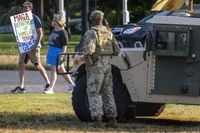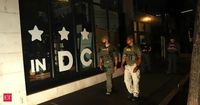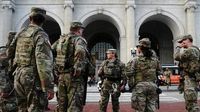On August 11, 2025, President Donald Trump stunned the nation’s capital with an announcement: roughly 800 National Guard troops would be deployed to Washington, D.C., in what he described as a necessary move to combat "violent gangs" and homelessness. The decision, which included federalizing the D.C. police, immediately set off a firestorm of political debate, legal maneuvering, and visible changes on the city’s streets. Yet, as the days ticked by, the facts on the ground—and in the crime statistics—painted a far more nuanced picture than the president’s dire warnings.
According to The Wall Street Journal and corroborated by The Economic Times, the initial wave of National Guard troops arrived unarmed, their presence intended as much for visibility and logistical support as for direct intervention. Troops could be seen in Humvees circling the National Mall and standing sentinel at high-traffic locations like Union Station. Their tasks ranged from administrative work to what officials called “area beautification,” a far cry from the frontline law enforcement roles many might expect. As Pentagon officials explained to India Today, the Guard had been trained in de-escalation tactics, drawing on their recent experience responding to protests in Los Angeles earlier in the summer, when over 4,000 Guard members and 700 Marines were mobilized in response to immigration-related protests.
Yet behind the scenes, the situation was shifting. By Thursday, August 14, about 200 troops were actively patrolling the city, according to the Defense Department and reported by The Independent. Late on Friday, some Guard members were told to prepare for an order authorizing them to carry weapons—a significant escalation—though no formal directive had been issued as of Saturday morning. The U.S. Army clarified in a statement that “weapons are available if needed but will remain in the armory.” Army officials told USA Today that while troops guarding national monuments would remain unarmed, those accompanying law enforcement on other missions might soon be authorized to carry pistols or rifles. The precise model of firearm, however, would not be determined until an official order was given.
The mission quickly expanded. On Saturday, August 16, West Virginia Governor Patrick Morrisey announced his state would send an additional 300 to 400 National Guard personnel to Washington, D.C., at the Trump administration’s request. "West Virginia is proud to stand with President Trump in his effort to restore pride and beauty to our nation’s capital," Morrisey said, as quoted by India Today. The deployment is set to include “mission-essential equipment, specialized training, and approximately 300–400 skilled personnel as directed,” Morrisey’s office confirmed. The mission, funded at the federal level, was described as a “commitment to public safety and regional cooperation.” A D.C. National Guard spokesman told The Washington Post that other states had also expressed interest in participating, though specific numbers remained unclear.
But the rationale for this sweeping deployment was hotly contested. President Trump, referencing a recent assault on Edward Coristine—a former Department of Government Efficiency staffer better known online as “Big Balls”—insisted that crime in D.C. was “out of control” and that only decisive federal action could restore order. "I have to say that somebody from DOGE was very badly hurt…a young man who was beat up by a bunch of thugs in DC, and either they’re gonna straighten their act out in the terms of government and in terms of protection or we’re gonna have to federalize and run it the way it’s supposed to be run," Trump declared on August 5, as reported by The Independent.
The president’s move to seize control of the Metropolitan Police Department and his attempt to install DEA Administrator Terry Cole as “emergency police commissioner” triggered immediate legal pushback. D.C. Mayor Muriel Bowser decried the move as an “authoritarian push,” while D.C. Attorney General Brian Schwalb celebrated a court ruling that blocked the administration’s attempt to override local control. "The outcome of today’s hearing is a win for Home Rule and upholds the District’s right to operate its own local police force," Schwalb wrote, adding, "Chief Smith and @MayorBowser rightfully remain in command of MPD." Instead, Attorney General Pam Bondi named Cole her “designee” and issued a directive requiring the Metropolitan Police Department to comply with federal immigration law and authorities.
Local officials were not shy about voicing their concerns. District Council Chairman Phil Mendelson accused Trump of "trying to create compelling TV," arguing, "National Guard soldiers are trained for warfare and natural disasters, not for community policing." Defense Secretary Pete Hegseth, however, signaled a more assertive role for the Guard. “We’re not going to have National Guards sitting there like this,” he said in a Fox News interview, crossing his arms, “seeing a crime committed and not do something about it.”
Yet, perhaps the most striking contradiction in the unfolding drama was the actual crime data. Despite the president’s repeated claims of rampant lawlessness, the Justice Department reported that violent crime in Washington, D.C., had been decreasing since 2023. In fact, 2024 saw the lowest violent crime rates in more than 30 years, with homicides, robberies, armed carjackings, and assaults with dangerous weapons all falling sharply. According to India Today, violent crime dropped 35% in 2024 compared to the previous year. This reality led many to question whether the deployment was truly about public safety or something else entirely.
Meanwhile, the logistics of the deployment reflected the unusual nature of the mission. Guardsmen who lived in or near D.C. slept at home, while those from farther afield stayed at military bases or hotels, as Army spokesperson Montrell Russell explained to USA Today. Between 100 and 200 Guardsmen would be on patrol with law enforcement at any given time, with the authority to detain people for law enforcement but not to make arrests themselves.
This deployment echoed President Trump’s first term, when he directed National Guard troops from D.C. and 11 other states to suppress protests in the summer of 2020 following the murder of George Floyd. Once again, the president’s use of extraordinary federal powers in the capital stirred debate about the balance between security and civil liberties, federal authority and local control.
As the city’s residents adjusted to the new normal—military vehicles on the Mall, armed troops potentially on the horizon, and the ever-present hum of political tension—the fundamental questions remained. Was this a necessary response to a genuine crisis, or an overreach fueled by political motives and public spectacle? With crime at historic lows and legal battles ongoing, the answer depended, as ever, on which side of the barricades you stood.



